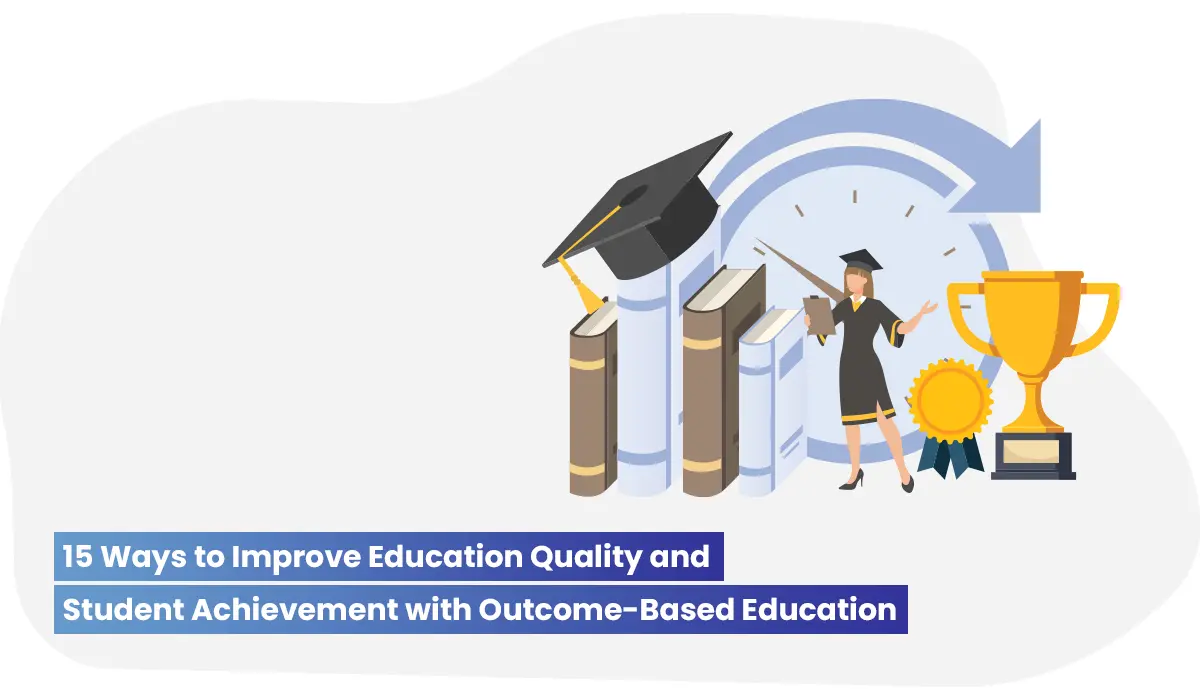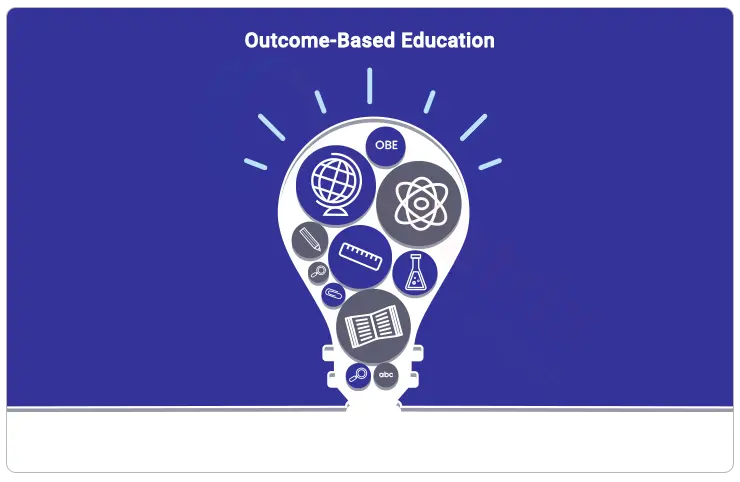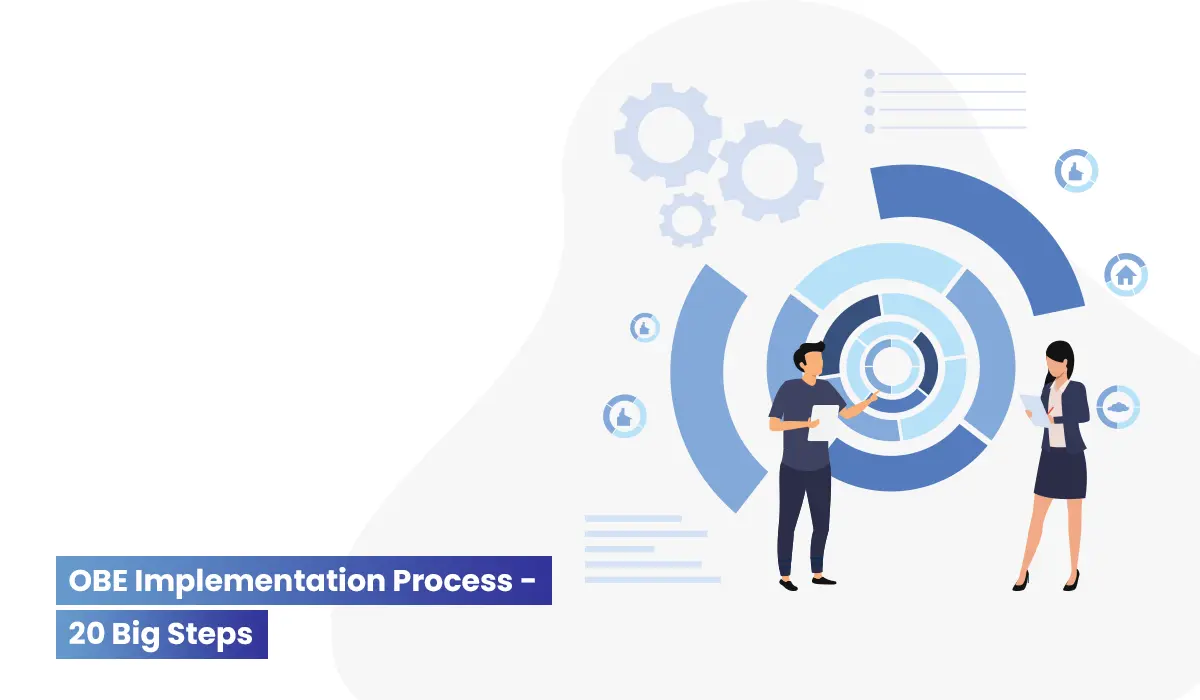15 Ways to Improve Education Quality and Student Achievement with Outcome-Based Education

What does improve education quality in higher education mean?
With economic growth and globalization, debates are brewing on how to improve the quality of higher education. Education programs focus on bettering student achievements. Focus on career, improving education quality, and professional development in the discussion. And here lies the answer.
A good, high-quality education has to do with outcomes. An outcome is a culminating demonstration of learning. It occurs after the completion of the academic program. It is a result of learning, which is a visible and observable demonstration of three main things—knowledge, combined with competence, combined with orientations. It is these three factors that determine the quality of higher education.

15 measures to improve quality education using outcome-based education
- Mission, Vision & Objectives
- Program Educational Objectives (PEO)
- Graduate Attributes (GA)
- Student learning outcomes (SLO)
- Program Outcomes (PO)
- Course outcomes (CO)
- Syllabus, Unit & Lesson Plan Outcomes
- Teaching Methods
- Assessment & Evaluation Tools
- Customizable Rubrics & Marking Schemes
- Continuous Quality Improvement (CQI)
- Outcome-based Education & Accreditation
- Student Success
- Constructive alignment
- Presentation of outcomes with automated mind mapping
How can education be improved?
Traditional education systems don’t provide students with the necessary knowledge and skills and fulfill performance expectations. OBE transforms education into personalized learning and enables education institutions to design instruction models tailored to the learning preferences of students.
Quality education comes with outcome-based education
OBE transforms education into personalized learning and enables education institutions to design instruction models tailored to the learning preferences of students. OBE is growing at astonishing rates all over the world. Every institution has a unique OBE framework to develop competent students to take on a professional career after graduation. All too often, this knowledge is not efficiently captured and used in higher education institutions. It is scattered in documents, spreadsheets, models, and people’s minds and buried in paperwork. What if the linking of curriculum processes could be more easily captured in education institutions as higher education software mind maps that can be processed, activated, shared, and reused to create better learning outcomes? What if there are better ways to improve education quality?
A move to implement software tools to support outcome-based learning, teaching, and assessments will benefit in many ways. It will improve learning outcomes and accelerate continuous quality improvement processes. Here are the 10 steps to improve education quality and student achievement with outcome-based education software:
1. Mission, Vision & Objectives
The central feature of OBE software is modeled to improve quality education. Thus, OBE prepares the mapping of the mission, vision, and values set by the institute with the program's educational objectives (PEOs).
2. Program Educational Objectives (PEO)
In terms of student achievement, PEOs are assessed for a longer duration. What the graduates are envisaged to achieve in their career 4-5 years after graduation. PEO attainment is based on stakeholder inputs using an online survey questionnaire. This will reveal that graduates are broadly satisfied with their achievement in all PEOs.
3. Graduate Attributes (GA)
Graduate attributes are often known as key skills, generic attributes, transferable, employability, and/or soft skills. Curriculum management software allows you to map graduate attributes to the curriculum design. This is to achieve the desired learning outcomes in real time.
4. Student learning outcomes (SLO)
A learning outcome is what a student can do as a result of a learning experience. It describes the attributes of their ideal graduates based on their visions, missions, institutional goals, or outcomes. And using these as bases for developing specific program outcomes. The three broad types of learning outcomes are disciplinary knowledge and skills, generic skills and, attitudes and values.
5. Program outcomes (PO)
Program outcomes are the sets of competencies (related knowledge, skills, and attitudes) that all learners are expected to demonstrate. These desired outcomes are mapped to the expected learning outcomes in specific courses. The desired course and learning outcomes are attained through assessment and evaluation tools.
6. Course outcomes (CO)
Course outcomes refer to the knowledge, values, and skills all learners are expected to demonstrate at the end of a course. Learning outcomes are mapped to course outcomes and program outcomes.
7. Syllabus, Unit & Lesson Plan Outcomes
Course outcomes lead to lesson outcomes. Create a syllabus, unit, and lesson plan to link with the learning outcomes of each teaching activity. This aids coherence and cohesion in student learning.
8. Teaching Methods
Technology-enabled performance demonstration of pedagogical learning through video lectures, podcasts, and slide presentations would innovate and enhance students’ learning experience. Technology-aided teaching methods and assessments would enable education institutions to accurately and perfectly map with the targeted outcome. This enables students and faculty to work together as partners toward achieving a visible and clear goal.
9. Assessment & Evaluation Tools
Implementing OBE further translates to the quality and orientation of the faculty members. The core mission of teaching is to build learning competencies. Online tests, assignments, quizzes, and puzzles, and evaluation of courses/faculty through a course evaluation survey questionnaire for the attainment of PEOs.
10. Customizable Rubrics & Marking Schemes
Assessment of writing, oral communication, critical thinking, or information literacy often requires rubrics. Automated rubrics are standardized scoring guides that assist evaluators in making assessments more transparent, easy, consistent, and objective. They even determine the quality of student work consistently.
11. Continuous Quality Improvement (CQI)
Quality in higher education comes with CQI. Online assessment and evaluation processes provide critical information to faculty and administrators. They also give real-time reports on the effectiveness of the program design, delivery, and objectives. CQI tools are based on a digital feedback loop through course/faculty evaluations easily. They will enable the institution to enhance the quality of education and the process will continue year after year.
12. Outcome-based Education & Accreditation
Yet another way for enhancement of quality of education in schools, and higher education is by gaining accreditation. The Accreditation Management System offers automated tools that enable higher education institutes to easily measure the achievement of outcomes. It also lets an institution improve the quality of higher education accordingly.
13. Student Success
There is a paradigm shift from traditional OBE to technology-based, learner-centered result-oriented OBE. This is reflected in the key purpose that technology enhances the learning and performance abilities of students before they leave the institution. Structuring colleges, universities, and higher education institutions to achieve and maximize the learning outcomes of students is the key to OBE principles.
14. Constructive alignment
Constructive alignment or linking learning outcomes to multiple curriculum elements is unique to OBE. Mapping skills, competencies, PEOs, PO & CO, teaching methods, and assessments with the learning outcomes foster better student achievement and educational quality.
15. Presentation of outcomes with automated mind mapping
Mind maps can be used to trigger & represent complex ideas and relationships, to assist one's thinking, writing, and decision-making. Students gain a non-linear form of outlining with mind mapping. The power of auto-generated mind maps represents the way curriculum elements are arranged, classified, and grouped instantly and easily.


